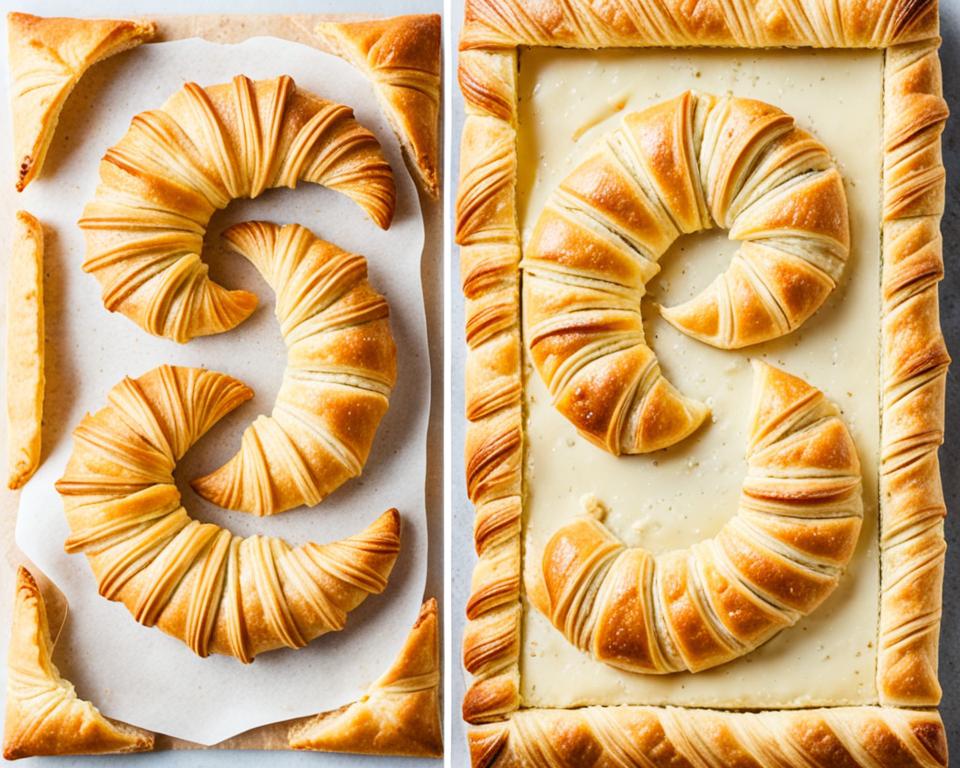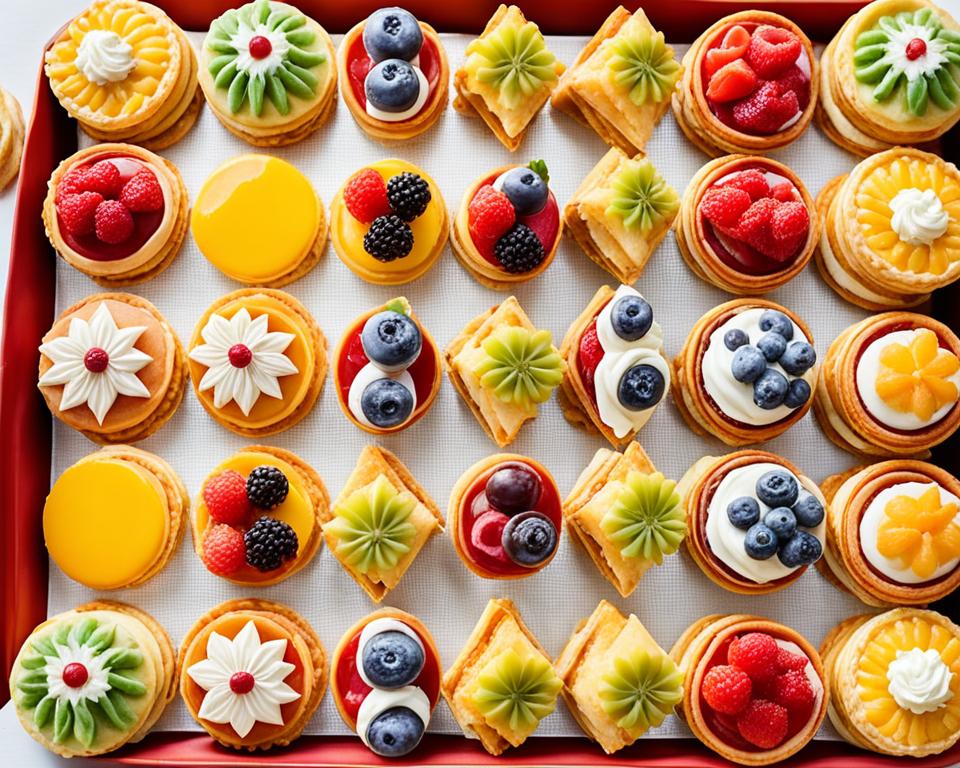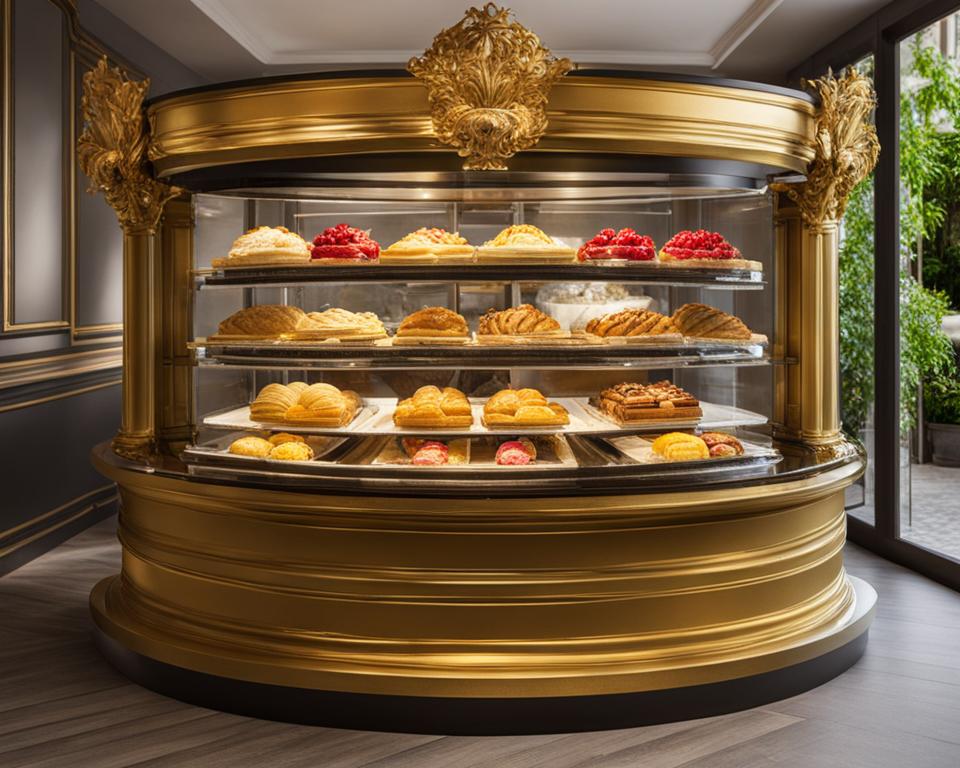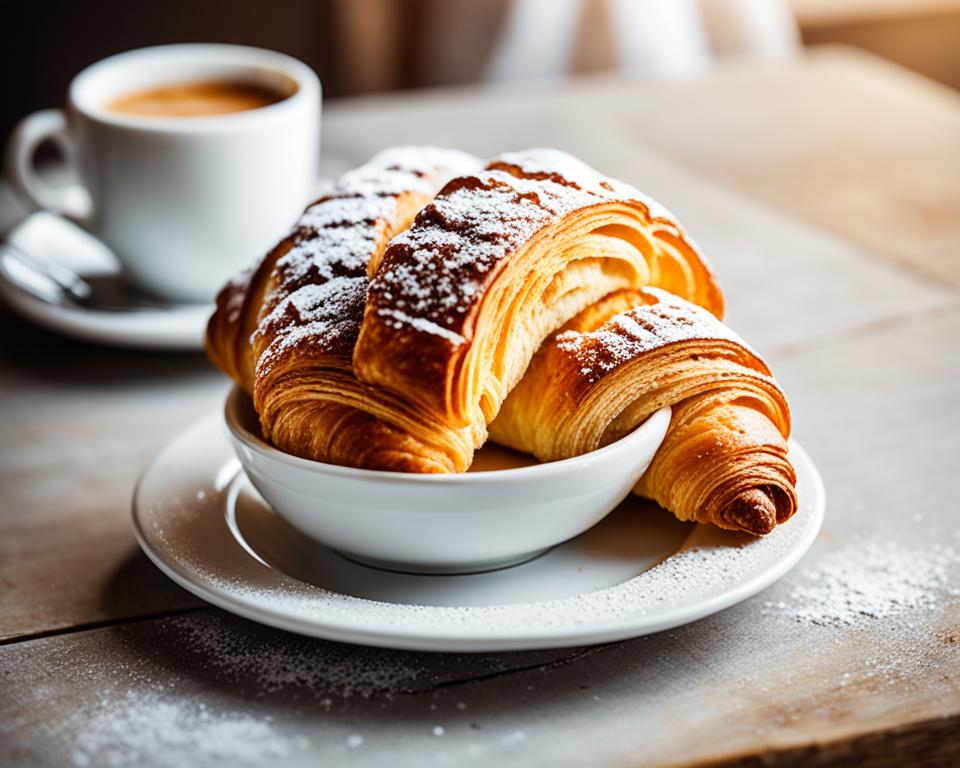In the realm of baking, pastries offer an indulgent escape to a world of flaky and flavorful delicacies. Among the popular choices in pastries, crescent rolls and puff pastry stand out for their versatility and the delectable experiences they deliver. Characterized by their flaky layers and often included in sweet and savory dishes, these two pastry types are frequently used in various recipes, from informal breakfasts to refined appetizers. But are crescent rolls puff pastry? While both pastries could be visually similar, primarily due to their flaky texture, they are indeed distinct.
Crescent rolls are the delightful result of a yeasted dough, enriched with butter and sugar, which upon baking, rise to fluffy perfection. Meanwhile, the crisp and intricate layers of puff pastry stem from a meticulous layering of butter within a non-yeasted dough, culminating in a beautifully puffed and airy bake. Understanding these differences is crucial for any baking aficionado and can make a substantial difference in the outcome of a dish.
Whether a baking enthusiast or a curious cook, the nuances between crescent rolls and puff pastry are worth knowing, as they cater to different tastes and textures that can elevate a myriad of dishes.
Key Takeaways
- Crescent rolls and puff pastry are distinct, with the former being a yeasted dough and the latter a non-yeasted, laminated dough.
- Both pastries can be used in sweet and savory recipes, but crescent rolls boast a fluffy texture, while puff pastry is known for its crispiness.
- The intricate process of making puff pastry, involving multiple layers of butter, contributes to its higher cost in comparison to other pastries.
- Both crescent rolls and puff pastry can be frozen, supporting convenient pre-preparation.
- Understanding the differences between these pastries enhances baking endeavors and ensures the right choice for every recipe.
Exploring the Comforting World of Baked Pastries
Delving into the arena of homemade puff pastry, pastry dough, and crescent roll dough reveals much more than what meets the eye or the palate. These elements form the cornerstone of baked goods that are beloved worldwide, tantalizing taste buds and evoking a sense of home with each bite. They are a testaments to the enduring allure and profound comfort that can be found in the simplicity of a well-baked treat. Indeed, navigating through the textures and flavors of these pastries unveils a rich tapestry of culinary history and innovation.
What Defines a Pastry?
At its most fundamental, pastry dough is a versatile mixture that primarily consists of flour, fats, and water sculpted by the warm touch of the baker’s hands. From the intricate layers of homemade puff pastry, marked by its buttery finesse, to the tender, spiraled escapes of crescent roll dough, each variant of pastry dough carries its own identity and purpose. Within these identities, the emblematic magic of baking unfolds, leading to an array of shapes, sizes, and flavors, each exceptional in its own right.
Satisfaction in Simple Baked Goods
The beauty of baked pastries lies not just in their comforting flavors but also in their humble origins. A scoop of flour, a pat of butter, and a dash of sugar – these basic ingredients intermingle to form the canvas upon which complex and delightful pastries are crafted. Whether they rise to the occasion as the foundations of grand desserts or are relished in their simplistic glazed or sugared forms, pastries resonate with our collective desire for small comforts and joyful treats in everyday life.
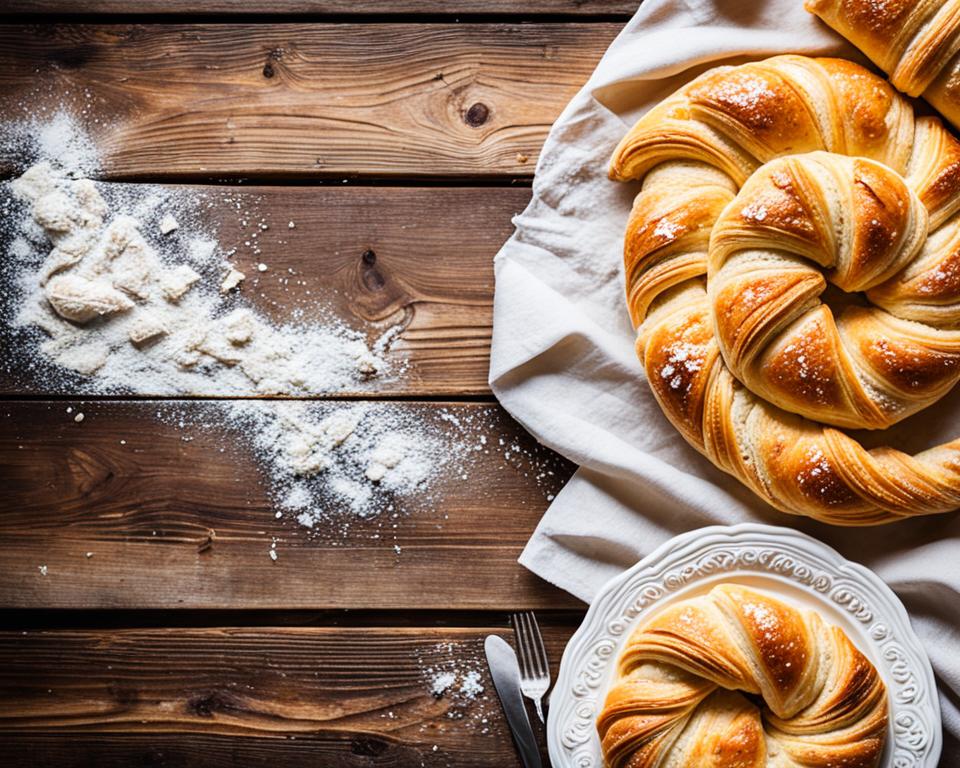
Indeed, from freshly baked crescent rolls adorning a brunch table to elegant vol-au-vents constructed from meticulously prepared puff pastry, these baked goods satisfy much more than just hunger. They satisfy the soul’s craving for artistry and joy that is often found in the kitchen’s warmth and the oven’s embrace. As connoisseurs of comfort food, we celebrate the enduring legacy of pastries – simple yet intricate, ordinary yet extraordinary.
Are Crescent Rolls Puff Pastry?
The culinary world often mulls over the distinction between crescent rolls and puff pastry, each marked by unique attributes that define their culinary roles. Understanding the particularities of these beloved pastries equips bakers and home chefs with the knowledge to craft exceptional dishes.
The crescent roll is a marvel of the baking world, a delectable creation born from a yeasted dough that imparts a characteristic sweet flavor and fluffy texture. Their delightful swell in the oven makes them a comforting breakfast selection, ready to be slathered with jam or shaped into savory delights.
On a different note, puff pastry commands attention with its crispy bite and neutral taste, hallmarks of its laminated, non-yeasted layers. Unlike the homey crescent roll, puff pastry is a master of diversity, effortlessly fitting into the frame of both sweet desserts and savory entrees. Its light, airy quality transforms simple fillings into gastronomic masterpieces.
Here lies the crux of their divergence: one is a soft, sweet bread-like entity, while the other is a versatile, flaky canvas awaiting a painter’s brushstroke. Both puff pastry and crescent rolls display profound culinary advantages and versatility, yet their individual characteristics make them each special in their own right.
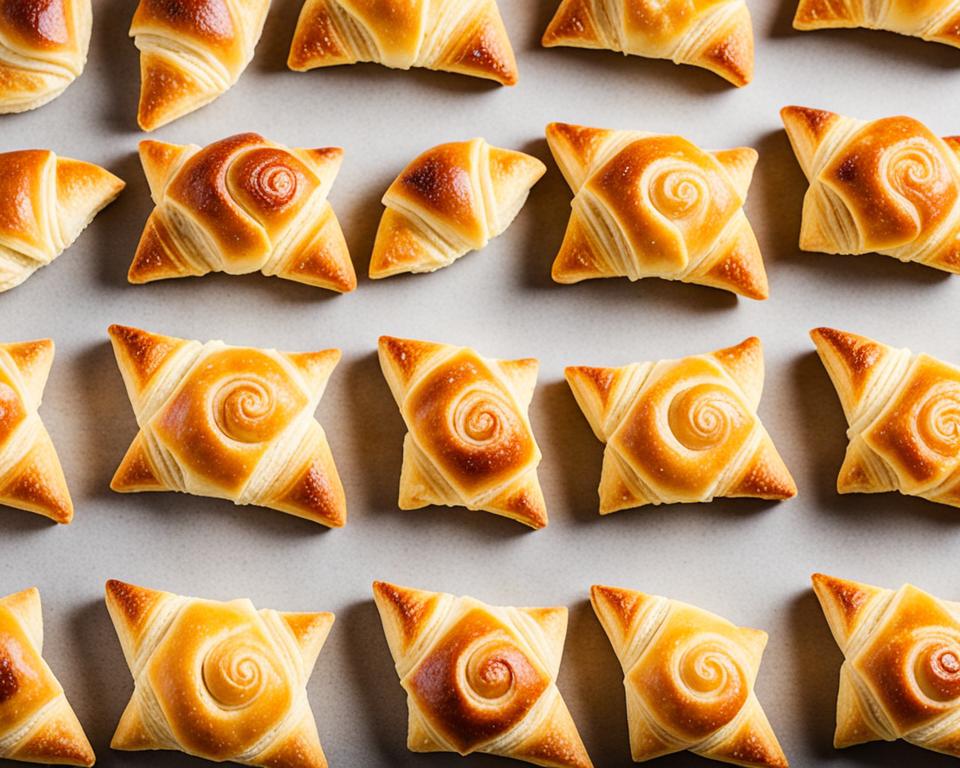
Let’s delve into a comparison to further illustrate the functional dichotomy between these two types of pastry:
| Crescent Roll | Puff Pastry |
|---|---|
| Yeasted Dough | Non-yeasted, Laminated Dough |
| Sweet Flavor Profile | Neutral Taste |
| Fluffy and Soft Texture | Crispy and Flaky Texture |
| Commonly Used for Breakfast | Adaptable to Both Savory and Sweet Dishes |
In summary, while visually they may occasionally be mistaken for one another, crescent rolls beam with a nostalgically sweet and tender texture suited for morning feasts and comfort food cravings. In contrast, puff pastry is a chameleon in the kitchen, lending itself to a vast array of culinary exploits, from flaky tarts to buttery, sophisticated entrées.
Understanding the Crafting of Crescent Rolls
Embark on a delightful journey into the heart of home baking with crescent rolls—a confection that marries the simplicity of dough with the rich flavors of butter and sugar. The creation of these pastries is not just an act of cooking but a form of culinary art, steeped in tradition and adored for their tantalizing textures and tastes. Crescent rolls epitomize comfort food with their warm, airy layers, inviting a sense of nostalgia and domestic bliss with every mouthful. Let’s explore the intricacies of their crafting and the variegated recipes they inspire.
The Yeasted Dough at the Heart of Crescent Rolls
The foundation of crescent roll recipes is a yeasted dough that is lovingly mixed with butter and sugar to yield a slightly sweet base that will rise to impressive fluffiness in the oven. The process begins with careful mixing and kneading, followed by rolling the dough into perfect thinness. The resulting flat surface is then artfully cut into triangles, each destined to become the iconic crescent shape. The transformation is completed by the oven’s warmth, where the rolls emerge as puffed symbols of homemade contentment.
Sweet and Savory Delights Made with Crescent Rolls
From the simplicity of rolls spread with jam or Nutella to creative concoctions like pigs in a blanket, crescent rolls are your canvas for both savory appetizers and sweet treats. Their versatility stretches to encompass everything from a hastily muster breakfast to inviting dinner pastries. The allure of these doughy spirals lies in their ability to pair with a multitude of fillings and toppings, adapting effortlessly to the whims of the occasion.
| Occasion | Crescent Roll Creation |
|---|---|
| Breakfast | Jam-filled crescent rolls |
| Snack | Cheese and herb crescent pinwheels |
| Lunch | Chicken salad crescent roll-ups |
| Appetizer | Spinach and feta stuffed crescents |
| Dinner | Mini crescent pizzas |
| Dessert | Chocolate hazelnut crescent twists |
Whether it’s an impromptu gathering or a thoughtfully planned meal, crescent roll recipes present a bounty of possibilities. They stand ready to assist in whipping up quick savory appetizers or rolling into sweet concoctions that bring joy to your table and warmth to your kitchen.
The Art of Making Puff Pastry
The creation of puff pastry is more than just a baking procedure; it’s an art that has been perfected over centuries, representing the pinnacle of pastry craft. This revered baking pastries tradition involves the precise lamination of dough with layers upon layers of butter, a task that calls for a blend of technical prowess and patience. The hallmark of a superior homemade puff pastry lies in its multitude of thin, delicate layers that, when subjected to the oven’s heat, spring up into a symphony of crisp, golden textures.
To understand the intricacy of this pastry, one must appreciate the thoroughness with which butter is intertwined with dough. During the laminating process, the pastry chef will meticulously fold the butter into the dough, turn after turn, chilling between each fold to ensure the butter remains distinct within the layers. This is not a task for the faint-hearted—it demands diligence and a careful hand.
Why commit to such a time-consuming task? The rewards are evident in the puffed splendor and peerless flakiness, qualities that elevate baking pastries to an art form. A well-crafted puff pastry is an emblem of elegance and refinement in the culinary world, bringing a sophisticated edge to both simple and sumptuous dishes alike.
Let’s break down the essential steps in creating this pastry masterpiece. The process generally begins with a détrempe, a simple dough of flour and water, which provides the base for the layers. Onto this, slabs of quality butter are placed, and the dough is folded over the butter, initiating the layering process. Each fold, or ‘tour,’ is performed with exact measurements and careful manipulation to avoid breaking through the delicate layers or melting the butter. The results are measured in the multitude of paper-thin layers that make puff pastry‘s distinct texture.
In acknowledgement of the labor involved, here’s an overview of the steps in crafting puff pastry:
- Preparing the détrempe (base dough)
- Encasing the butter within the dough
- Executing a series of folds, known as ‘tours’
- Chilling the dough between each set of folds
- Final rolling out before shaping and baking
These methodical repetitions culminate in a dough replete with hundreds of fine layers, a testament to the skill of the baker. The puff pastry effective use isn’t limited to specific recipes; it serves as the foundation for innumerable culinary creations. From the quintessential French croissant to the sublime mille-feuille, puff pastry is the cornerstone on which these classic treats are built.
For the home chef looking to venture into the realm of homemade puff pastry, know that your endeavors will be generously rewarded. The satisfaction of cutting into a pastry and observing the stratified interior, not to mention the buttery aroma pervading the kitchen, is nothing short of bliss. While the process may at times test your patience, the resulting puff pastry, with its grandeur and grace, will undoubtedly be a source of pride.
Key Differences Between Crescent Rolls and Puff Pastry
When stepping into the fragrant world of bakeries and home kitchens, one is bound to encounter the delectable dilemma of choosing between crescent rolls vs puff pastry. Though both pastries may seem similar at a glance with their golden hues and flaky textures, they are distinctly different in composition, taste, and culinary application.
Texture and Taste Distinctions
The discerning palate can easily detect the texture contrast between the two pastries. Crescent rolls offer a soft, fluffy texture akin to bread, with a gentle sweetness yielded by their sugared dough. This makes them a delightful addition to the breakfast table, often becoming the vessel for comforting fillings like jam or honey. The taste and texture of puff pastry, however, boasts a crisp and airy structure that results from the intricate process of layering dough and butter, without the addition of sugar, resulting in a neutral flavor profile. This makes puff pastry an adaptable element in both savory and sweet culinary creations, ranging from appetizing turnovers to decadent desserts.
Ideal Uses for Each Type of Pastry
Understanding the pastry uses for each is key to mastering the art of baking. Crescent rolls are the quintessential choice for a dish that demands a dough with an ability to hold shape and offer a tender chew, such as with pinwheels or stuffed rolls. Puff pastry, on the other hand, shines as the cornerstone for recipes that call for a flaky, refined finish. Its versatility makes it a fitting base for elegant appetizers like vol-au-vents, sumptuous pies, or even delicate pastries. Thus, in the vibrant world of pastries, crescent rolls and puff pastry play their distinctive roles, serving bakers and gourmets alike with their unique offerings.
FAQ
Are crescent rolls puff pastry?
Crescent rolls are not puff pastry. Crescent rolls are made from a yeasted dough that includes butter and sugar, resulting in a fluffy, subtly sweet bread-like roll. Puff pastry, meanwhile, is made from a laminated dough that involves layering butter but does not contain yeast, leading to a flaky, crisp texture and a more neutral taste.
What defines a pastry?
A pastry is typically a dough made from flour, water, and fat which is used as a base for baked goods. It can vary in texture from flaky and light to dense and rich, depending on the type and amount of fat used, and whether it has been leavened with yeast or other rising agents.
Can you find satisfaction in simple baked goods?
Absolutely, many people find comfort and satisfaction in the simplicity and traditional preparations of baked goods like homemade puff pastry and crescent roll dough. The versatility of these pastries allows them to be enjoyed in a range of simple to gourmet dishes.
What is the yeasted dough at the heart of crescent rolls?
The yeasted dough at the heart of crescent rolls is a rich, buttery dough that includes a small amount of sugar and yeast. This combination allows the dough to rise and become fluffy when baked, providing the characteristic texture of crescent rolls.
What kinds of sweet and savory delights can be made with crescent rolls?
Crescent roll dough is incredibly versatile and can be used to create both sweet and savory delights. Sweet treats might include rolls filled with chocolate or fruit preserves, while savory appetizers could encompass pigs in a blanket, spinach and cheese pinwheels, or chicken pot pie crescent braid.
How is puff pastry made?
Puff pastry is made by the artful process of laminating dough, which involves folding butter into the dough numerous times to create many thin layers. This technique allows the pastry to puff up and become extremely flaky when it’s baked, as the water in the butter turns to steam, separating the layers of dough.
What are the key differences between crescent rolls and puff pastry in terms of texture and taste?
Crescent rolls have a fluffy, bread-like texture with a touch of sweetness, while puff pastry has a flaky, light, and crisp texture with a neutral taste. These differences arise from their distinct dough preparation processes and ingredient compositions.
What are the ideal uses for each type of pastry?
Crescent rolls are ideal for recipes that require a dough which will rise and hold its shape, such as breakfast rolls or stuffed bread. Puff pastry is best for dishes that need a crisper, flakier outcome, like vol-au-vents, croissants, and turnovers.

